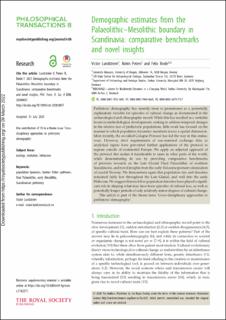| dc.contributor.author | Lundström, Victor | |
| dc.contributor.author | Peters, Robin | |
| dc.contributor.author | Riede, Felix | |
| dc.date.accessioned | 2022-03-21T09:25:59Z | |
| dc.date.available | 2022-03-21T09:25:59Z | |
| dc.date.created | 2022-01-17T13:30:50Z | |
| dc.date.issued | 2021 | |
| dc.identifier.issn | 0962-8436 | |
| dc.identifier.uri | https://hdl.handle.net/11250/2986366 | |
| dc.description.abstract | Prehistoric demography has recently risen to prominence as a potentially explanatory variable for episodes of cultural change as documented in the archaeological and ethnographic record. While this has resulted in a veritable boom in methodological developments seeking to address temporal changes in the relative size of prehistoric populations, little work has focused on the manner in which population dynamics manifests across a spatial dimension. Most recently, the so-called Cologne Protocol has led the way in this endeavour. However, strict requirements of raw-material exchange data as analytical inputs have prevented further applications of the protocol to regions outside of continental Europe. We apply an adjusted approach of the protocol that makes it transferable to cases in other parts of the world, while demonstrating its use by providing comparative benchmarks of previous research on the Late Glacial Final Palaeolithic of southern Scandinavia, and novel insights from the early Holocene pioneer colonization of coastal Norway. We demonstrate again that population size and densities remained fairly low throughout the Late Glacial, and well into the early Holocene. We suggest that such low population densities have played a significant role in shaping what may have been episodes of cultural loss, as well as potentially longer periods of only relatively minor degrees of cultural change.
This article is part of the theme issue ‘Cross-disciplinary approaches to prehistoric demography’. | en_US |
| dc.language.iso | eng | en_US |
| dc.publisher | The Royal Society | en_US |
| dc.rights | Navngivelse 4.0 Internasjonal | * |
| dc.rights.uri | http://creativecommons.org/licenses/by/4.0/deed.no | * |
| dc.title | Demographic estimates from the Palaeolithic–Mesolithic boundary in Scandinavia: comparative benchmarks and novel insights | en_US |
| dc.type | Journal article | en_US |
| dc.type | Peer reviewed | en_US |
| dc.description.version | publishedVersion | en_US |
| dc.rights.holder | Copyright 2020. The Authors | en_US |
| dc.source.articlenumber | 20200037 | en_US |
| cristin.ispublished | true | |
| cristin.fulltext | original | |
| cristin.qualitycode | 2 | |
| dc.identifier.doi | 10.1098/rstb.2020.0037 | |
| dc.identifier.cristin | 1982558 | |
| dc.source.journal | Philosophical Transactions of the Royal Society of London. Biological Sciences | en_US |
| dc.identifier.citation | Philosophical Transactions of the Royal Society B. Biological Sciences. 2021, 376 (1816), 20200037. | en_US |
| dc.source.volume | 376 | en_US |
| dc.source.issue | 1816 | en_US |

